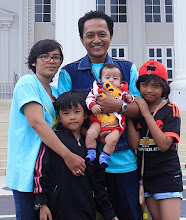After the Komodo Island National Park was dumped from New 7 Wonders last year, the good news came from its neighbour island, the Flores Island. On August 27, 2012, at the announcement of the 2012 Asia Pacific Heritage Award, in Bangkok, Thailand, Mbaru Niang received the UNESCO's Award of Excellence.
The 10 Centuries Civilization
Mbaru Niang, which in Manggarai language means cone house, a traditional house of Wae Rebo village, Manggarai district, Flores Island, East Nusa Tenggara. There is only 7 houses left in the world, so that it makes 7 Wonders of Indonesian Houses.
Wae Rebo village is located about 1,100 meters above sea level, an isolated village surrounded by panoramic mountains and dense jungle. Wae Rebo village had survived for more than 1000 years, its people now are the 17th generation. Isidorus Ingkul, 84, is the living elder of the 16th generation. According to Isidorus, the life expectancy of every generations in Wae Rebo was about 60 years.
The Journey
A visit to Wae Rebo is made through the district's capital of Ruteng. From the nearest big city of Ruteng, the journey continued with a hard ride to Denge village. Based on the journey by Jawa Pos Reporter, Doan Widhiandono, on September 7, 2012, there are still 4 routes before reaching the Wae Rebo village, that must be on foot to be arrived there.
The Tour de Wae Rebo
, said Doan, was started exacly at 2.12 pm East Indonesia Time (UTC+9). The 1st route is Denge - Wae Lomba, across the Coffee and Cacao field. Normally can be finished in 45 minutes, but for Doan the 1st route was far away from normal. Accompanied by Romanus Monde, his guide, he finished the 1st route in 90 minutes, due lots of taking a break.
The 2nd route is Wae Lomba - Posoroko, in which the road was more softer, no more big rocks that must be jumped. Only flat ground which climbed, and keep on climbing. The 2nd route track was not so steep, with the steep slope was only about 30 degrees. He took about an hour on the 2nd route.
On the short 3rd route, Posoroko - Nampe Bakok, Doan was still felt the same torture just as both route before. He arrived to the 3rd post of Nampe Bakok after 30 minutes.
The last route, the final one, Nampe Bakok - Wae Rebo, was a downhill track. He finally arrived in Wae Rebo at 5.58 pm. Crossing in the middle of the small village towards Mbaru Tembong, the main and the biggest of Mbaru Niang in Wae Rebo.
The Cone House
Mbaru Niang has ngando, the main pillar made from Worok wood. While the frame hood of the cone is made from bamboo. Every Mbaru Niang also has paratongang, unique traditional windows. All the houses were built without the use of nail.
Mbaru Tembong is on the East side of Wae Rebo, and at the center amongs others 6 Mbaru Gena, the ordinary Mbaru Niang, on its left and right. Mbaru Tembong has 15 meter of height and the cone diameter. The others 6 Mbaru Gena only have 11 meter of height and the cone diameter.
All 7 Mbaru Niang were built in 5 levels. The 1st level, lutur, is for living. Mbaru Tembong is filled with 8 families, direct descendants of Maro, the 1st generation of Wae Rebo. Other Mbaru Niang is filled with 6 families.
The 2nd level, lobo mehe, is to store foods and goods. The 3rd level, lentar, is to store seeds. The 4th level, lemparae, is for foods stocks. At the 5th level, hekang kode, there's a room called, kilikiang, to keep offerings to the ancestors.
Saving The Heritage
In 2008, Mbaru Niang was almost extinct, due to was only 4 houses left, that is Mbaru Tembong, a house on the left side, and 2 houses on the right side. 3 other houses were vanished because of age.
According to Vitalis Haman, one of the elders of the 17th generation, the number of Mbaru Niang in Wae Rebo must not more than 7 houses. Seven is represented of the seven powers which guard our village,
said Vitalis.
In 2011, the community-led rebuilding project, initiated by the Rumah Asuh Foundation, had re-built 3 other houses. The project were also helped by the donations from Tirto Utomo Foundation, Arifin Panigoro, a businessman, and Admiral Sukardi, former Indonesian Minister. The cost to build each Mbaru Niang was more than IDR Rp300 Million (USD $32,000).
References:
- Photo Credit: Leonardus Nyoman
- Jawa Pos, Headline, September 15 & 16, 2012
Menyinggahi Wae Rebo, Desa di NTT Peraih Penghargaan Tertinggi UNESCO (2),(3/Habis) - JPNN.COM : Menyinggahi Wae Rebo, Desa di NTT Peraih Penghargaan Tertinggi UNESCO (1)
- UNESCO Office in Bangkok
UNESCO Asia-Pacific Awards for Cultural Heritage Conservation
Winners of the 2012 UNESCO Asia-Pacific Awards (archive)
Update: July 17, 2024


























No comments:
Post a Comment
Please read the comment policy before commenting!